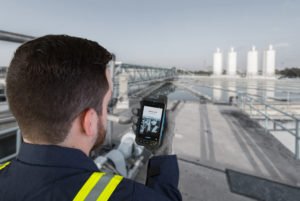For health and safety managers working in small and medium-sized enterprises (SMEs), time and budget constraints are an important part of any business decision, while keeping on top of safety compliance and legislation can be costly and time-consuming. Praveen Sharma, Director of Connected Worker Products at Honeywell Safety and Productivity Solutions looks at how cloud-based technology can help SME safety managers work smarter.

Smart phones put a raft of data collection and presentation at your fingertips
Staying ahead of current safety and health legislation and remaining compliant is now an essential part of any size of business. This is particularly true for those SMEs where resources are stretched and the implications of a possible £115,000 fine (the average across all industries) if found guilty of a health and safety breach can be far-reaching.
One key challenge for safety managers in SMEs is finding themselves spread across a range of tasks such as facilities and building management. At times, they might struggle to find time to dedicate to essential yet time-consuming health and safety compliance work. This is where technology comes in.
Advances in health and safety technology – specifically big-data automation – have shifted the approach to risk-management from one of pure compliance to a process that is becoming more information-based. This rise in technology has not been matched in cost, meaning that it is now more affordable and accessible for smaller firms to take advantage of.
Big-data automation
To remain health and safety compliant, information such as readings and time-frames need to be constantly monitored and reacted to if necessary. Producing permits to work and testing personal protective equipment (PPE), for example, requires a certain amount of this type of information to be collected before sign-off. However, technology now allows for this data to be captured automatically without the need for time-consuming manual input, which has traditionally been the approach taken by SMEs.
Big-data automation enables analytics on a huge-scale that quickly and efficiently produces accurate reports, statuses and can therefore form part of a strong safety management programme for smaller outfits.
In a time where the internet is more than just a desktop computer, we are now part of the internet of things (IoT), a term that illustrates the data-sharing connectivity of physical appliances such as laptops, tablets, vehicles and even household appliances. However, it’s a device used daily by most people that is really driving the revolution in data-automation: the smart phone.
Simple, affordable and valuable
These days, smart phone users are comfortable and confident in operating their devices: sharing updates, locations and information constantly means useful data is being gathered on a large scale. For SMEs, the smart phone can also prove an accessible, affordable and valuable tool for maintaining safety compliance.
The average smart phone device comes with a range of built-in features such as Bluetooth, Wi-Fi and 4G connectivity as well as GPS location technology, all of which can play an important role in monitoring, for example, the whereabouts of a lone-worker.
 Push-to-talk walkie-talkies, once the main tool for on-site/off-site communication, are becoming less common as the smart phone turns the worker into a personal communication hub sharing safety data across a connected worker platform. At the heart of this sits the data suite, which can be viewed on a real-time dashboard by a safety manager.
Push-to-talk walkie-talkies, once the main tool for on-site/off-site communication, are becoming less common as the smart phone turns the worker into a personal communication hub sharing safety data across a connected worker platform. At the heart of this sits the data suite, which can be viewed on a real-time dashboard by a safety manager.
Bluetooth connectivity means a smart phone is also able to sync with other safety devices such as gas-detectors and noise dosimeters allowing for exposure levels to be monitored in real time, rather than transmitting data through a docking system.
If a worker was exposed to dangerous levels of noise during a shift, for example, and then forgot to dock their device, the incident would not be flagged until the next docking opportunity. This means not only potential harm to the individual, but also a potential breach for the company and a long process of investigation into the incident.
Devices fitted with real-time data automation mean that the exposure will have already been recorded within a central suite without the need for instrument docking. Again, access to this data enables the safety manager to be pro-active in taking action and intervene before the worker is exposed to increasingly dangerous levels of gas or noise, for example.
Avoiding errors
As previously mentioned, for many SMEs the process of safety management is often a manual one. Data is collected and fed into spreadsheets, which can lead to oversights. Real-time data capture means that evidence of compliance is gathered automatically, thus avoiding errors. For example, prior to a worker being sent into a confined space environment, the data suite will show how all the necessary steps, compliance-wise, have been taken, including issuing the correct PPE and ensuring that the workers are suitably trained.
When a health and safety audit is required the information will be readily available for an auditor to view, significantly speeding up a process that, for some SMEs, can be complicated, time-consuming and frustrating.
PPE register
Of course, keeping PPE well-maintained and fit-for-purpose is a legal requirement that SMEs cannot afford to overlook. A poorly maintained register can contribute to the problem.
For many SMEs, maintaining a PPE register is again a manual approach. A spreadsheet listing the assets and their expiry deadlines and inspection dates is often the most popular system. Yet, this approach is prone to human error meaning an item due for inspection or indeed no longer fit for work could be overlooked, increasing the risk of non-compliance during an audit.
To counter this, a safety manager can upload an entire database of their PPE including model number, manufacturer, inspection date and expiry date into an asset management suite. Once uploaded, the system will alert the safety manager when a specific piece of equipment requires maintenance and in some cases also provide guidance on how to carry out an inspection.
Similarly, if a gas detector requires calibration once a month then that schedule can be programmed into the software and that piece of equipment will be calibrated automatically to that schedule, enabling SMEs to save a significant amount of time while ensuring compliance.
Smart safety management
Ultimately, for an SME, the best-way to improve productivity and avoid costly fines is to prevent an incident in the first place. With the advent of big-data automation becoming more accessible, this smarter approach to safety management is keeping smaller companies compliant and more productive.
According to the EU-OSHA, good occupational safety and health is fundamental to the success and long-term survival of SMEs and real-time worker connectivity is one way to get there. It is empowering people to react before something bad happens, preventing incidents and so taking safety to the next level.
Approaches to managing the risks associated Musculoskeletal disorders
In this episode of the Safety & Health Podcast, we hear from Matt Birtles, Principal Ergonomics Consultant at HSE’s Science and Research Centre, about the different approaches to managing the risks associated with Musculoskeletal disorders.
Matt, an ergonomics and human factors expert, shares his thoughts on why MSDs are important, the various prevalent rates across the UK, what you can do within your own organisation and the Risk Management process surrounding MSD’s.


 Push-to-talk walkie-talkies, once the main tool for on-site/off-site communication, are becoming less common as the smart phone turns the worker into a personal communication hub sharing safety data across a connected worker platform. At the heart of this sits the data suite, which can be viewed on a real-time dashboard by a safety manager.
Push-to-talk walkie-talkies, once the main tool for on-site/off-site communication, are becoming less common as the smart phone turns the worker into a personal communication hub sharing safety data across a connected worker platform. At the heart of this sits the data suite, which can be viewed on a real-time dashboard by a safety manager.
This is an interesting article and a topic which certainly has mileage going forward as we continue to use technology to improve safety and operational efficiency. Many Digital Control Systems (DCS) applications are extendable to other PC’s and devices already but I do however challenge the use of smartphones to accomplish this on sites where hazardous substances may be present as mentioned above due to their lack of intrinsic safety. The data suite can be accessed by Managers who require information such as readings, positions of valves and equipment states but the use of a typical smartphone is not allowed… Read more »